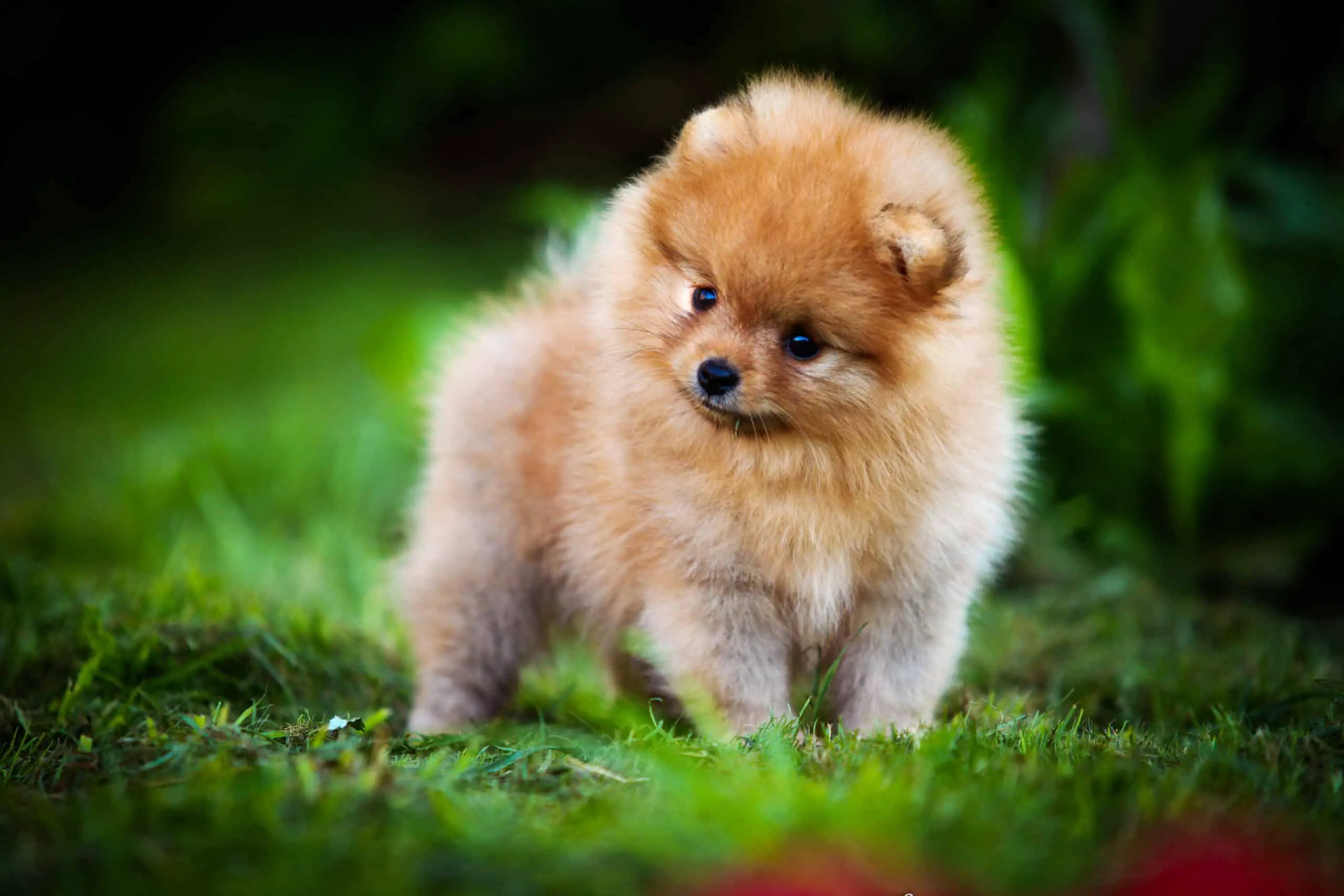Our website is supported by our users. We sometimes earn money when you click an affiliate link and make a purchase. This is at no extra cost to you and helps us to create quality content. Thank you so very much for your support.
Teacup Pomeranians are one of the most popular breeds of dogs in the world today, and for good reason. They are small, cute, and incredibly friendly, making them ideal pets for many households. In this article, we will explore the history, physical characteristics, and other important information about the Teacup Pomeranian.
History of the Pomeranian Dog
The Pomeranian breed of dog originated in the region of Pomerania, which is now known as Northern Germany and upper Poland.
They were originally bred to be larger dogs, used for hunting, guarding and even sled dogs.
However, as the breed gained popularity, breeders began selectively breeding them to be smaller and more docile, resulting in the Teacup Pomeranian, also called toy Pomeranians or miniature Pomeranian we know today.
Despite their small size, Full size Pomeranians and Teacup Poms are still considered to be part of the Spitz family of dogs, which includes breeds such as the Husky and Malamute.
You see similarities between the Pomeranian, Husky and Malamute with a long, fluffy coat, a thick and feathered, curling tail and high intelligence.
In 1888, the Pomeranian was recognized by the American Kennel Club.
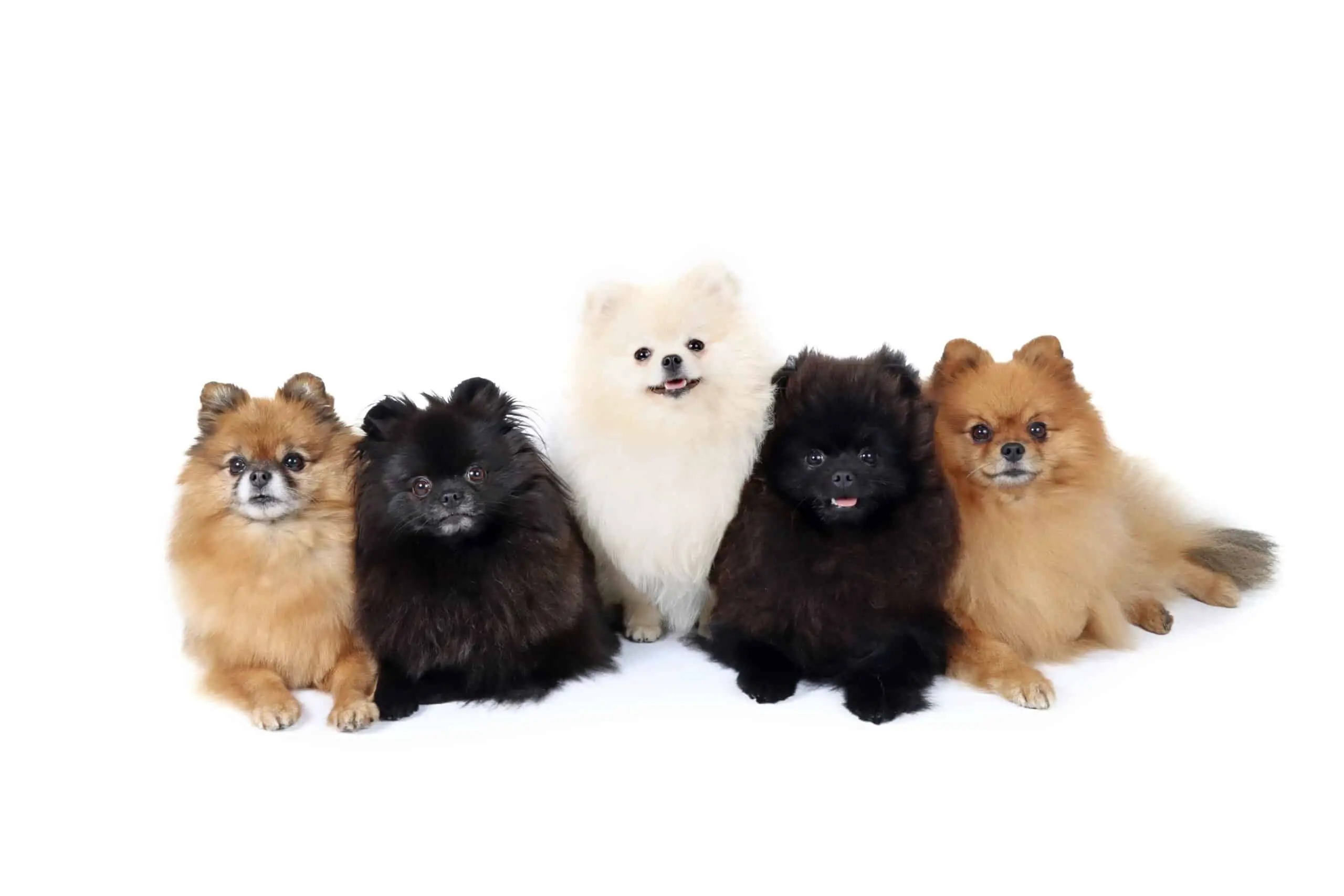
Physical Characteristics of the Teacup Pomeranian
Teacup Pomeranians are incredibly small dogs, weighing between 2 and 5 pounds when they are adult size. They have a distinctive “fox-like” appearance, with pointed ears, a fluffy, curly tail and big round eyes.
Their coats can come in a variety of colors, including white, black, brown, and orange. Teacup Pomeranians have a thick, double coat that requires regular grooming to prevent matting and tangling.
Their adult coat can be soft and silky or a thicker and spongier. The thicker coat usually results in the teddy bear Pomeranian look that show dogs have.
They have a life span of 12-16 years. That said, the oldest Pomeranian on record lived to the age of 21 years, 8 months and 13 days.
One of the most distinctive physical characteristics of the Teacup Pomeranian is their tiny size. While this may make them more fragile than larger breeds, it also makes them incredibly portable and easy to take with you on the go.
In 2014, Paris Hilton purchased the smallest purebred Pomeranian puppy for $13,000. The teacup breed, named Mr. Wonderful, weighed in at just 11.6 ounces and was 2.5 inches tall.
They are a popular choice for people who live in apartments or small houses, as they don’t require a lot of space to be happy and healthy. Dog owners who live in high rise apartments find that building a place where their dog can relieve itself on the balcony makes life infinitely easier.
And since they are such small dogs, the potty area doesn’t need to be overly large either. Check out our article on how to build a dog potty on concrete.
Also, because they are so small and may need potty breaks if their owners are unavailable to even let them out on the balcony.
For that reason, we trained our dog, Phoebe La Rue, to use a cat litter box. She did very well with it.
If you are going to use cat litter, be sure to use a high quality litter, because your dog will be sniffing it to know where to go.
Crystalline silica dust is seen in some clay litters of lower quality. Crystalline silica is thought to be a cancer-causing substance and is not biodegradable. A condition known as silicosis, which results in breathlessness and diminished lung capacity, can develop over time as a result of crystalline silica building up in the lungs of your dog.
And when you clean it, leave a little bit of dirty litter in it because dog’s will continue to go potty in the same place, but only if
they smell it.
Though it is harder to find, there is litter that is specifically made for dogs. So Phresh Dog Litter with Odor Control Paper will do the trick in absorbing liquid while keeping odor down. Another one is Fresh News Recycled Paper that also controls odor.

Temperament of Your Teacup Pomeranian
Teacup Pomeranians are known for being friendly, affectionate, and outgoing. They are highly social dogs and thrive on attention and interaction with their owners.
Despite their small size, they are surprisingly energetic and require regular exercise to stay healthy and happy.
Remember, one of your strides is more likely quite a few of theirs so a small walk is fine. And be prepared to carry them if they get tired out before you get home.
They are also intelligent dogs, which means they can quickly learn new tricks and commands. However, they can be prone to excessive barking, thinking they are guard dogs, especially if they are not trained properly. Which can be a problem if you live in an apartment or have close neighbors.
It’s a good idea to provide early training sessions mini Pomeranian to curb this behavior.
Unfortunately, they sometimes have small dog syndrome and despite their small stature, will go after dogs (or critters) that are bigger than them.
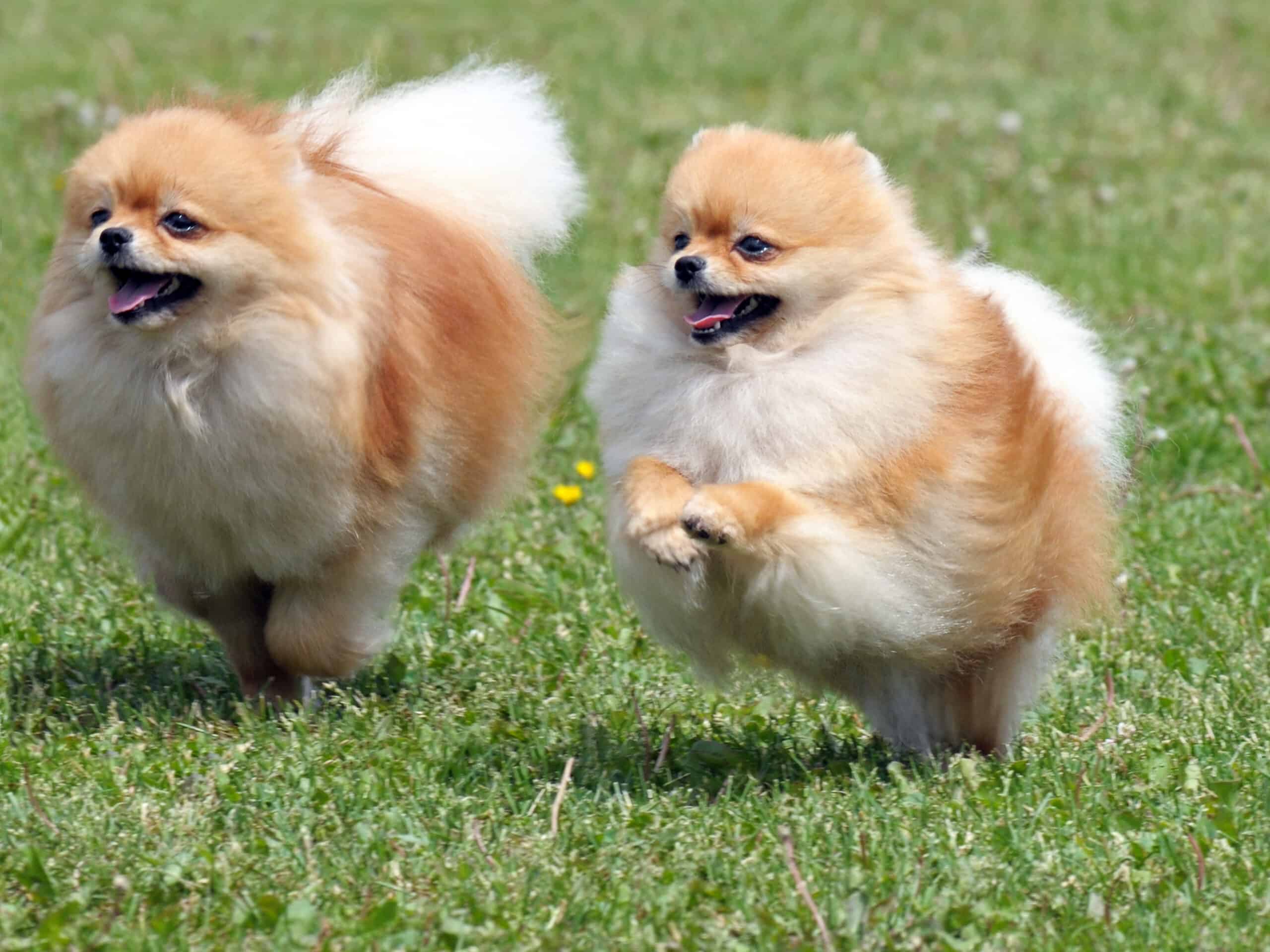
Training and Exercise for Your Teacup Pomeranian
Teacup Pomeranians are highly trainable and respond well to positive reinforcement methods. They are intelligent dogs, which makes training them easier than many other breeds.
It’s essential to start training them at a young age, and you should use positive reinforcement techniques, such as praise and treats, to encourage good behavior.
Our Pom had the added bonus of not being food motivated, so she was a bit difficult to train her.
Teacup Pomeranians are energetic dogs, and they require daily exercise to stay healthy and happy. Despite their small size, they enjoy walks and playtime, and you should ensure that they have regular opportunities to run and play.

Common Health Problems for the Teacup Pomeranian
Teacup Pomeranians, are prone to several health issues, many of which are common among small breeds.
Hypoglycemia
Another one of the common health conditions that little dogs are predisposed to is hypoglycemia. It occurs when blood sugar levels fall to risky levels, leading to weakness, seizures, and in extreme circumstances, death.
Due to their small size and high level of energy, Teacup Pomeranians are especially vulnerable to this illness. To avoid hypoglycemia, it’s critical to give them regular meals and snacks.
Conversely, it is important that you don’t overfeed your Pom as they are also prone to obesity.
Luxating Patella
Luxating patella refers to when the kneecap moves out of the groove it is supposed to remain in. The slippage of the knee can cause ligament tears, cartilage damage, inflammation, discomfort, and soreness.
Depending on the severity of the condition, the symptoms may range from being unable to support any weight at all to being able to hold up the affected leg for a short distance.
One of the most prevalent medical issues in petite breeds, like as the Teacup Pomeranian, is patellar luxation. It happens when the dog’s kneecap slips out of place, resulting in pain and discomfort for the dog.
To fix this problem, some Teacup Pomeranians might need surgery, while others might merely require medication and rest.
The patella can occasionally be helped back into place by manipulating the leg. When it happened to our Pomeranian, we did as follows: While she is laying on the opposite side of the afflicted knee, we would gently grip her foot and push its leg in a circle while keeping it flat, much like if she was riding a bike.
To further explain, if your dog’s patella has slipped from it’s left knee, you would lay them on their right side. Then gently hold your dogs left foot, and rotating the entire leg and hip joint in a counter clockwise circle. Conversely, if your dog’s right knee has come out, lay her on her left side and manipulate the joint in a clockwise circle.
Do this EXTREMELY softly and relatively slowly. While going Too slowly can make the discomfort last longer and prevent the kneecap from popping back into position as necessary, going too fast and you also risk the kneecap from going back into place.
That was an effective treatment for our dog, but as always, consult your vet to be sure it is the right course of action for your dog’s luxating patella.
Anti-inflammatory drugs, weight management, and exercise limitation are frequently used. Yet in more severe circumstances, surgery might be required.
Heart Problems
There are several serious heart health issues plaguing this toy-sized pup.
Patent Ductus Arteriosus, or PDA
According to the Central Texas Veterinary Specialty & Emergency Hospital:
Poms are susceptible to a condition called patent ductus arteriosus, or PDA, in which a small vessel that carries blood between two parts of the heart does not close as it should shortly after birth. This results in too much blood being carried to the lungs, causing fluid build-up and strain on the heart.
In their senior years, heart failure is the major cause of mortality among Pomeranians. In the case of teacup Pomeranians, the majority of heart failure cases are brought on by weakening or gradual deformation of the heart valves, which causes blood to leak back around them and put strain on the heart.
Heart murmurs are present in animals with heart valve disease, also known as mitral valve disease. If your dog exhibits any visible symptoms of heart illness or a heart murmur, have your vet assess the severity of the condition and have them performed at least once a year.
Early detection of heart valve problems and medications could provide your pet a long, healthy life. Veterinary dental care, fatty acid supplements, and weight management can all help prevent heart disease and lessen its symptoms.
Allergies
Teacup Pomeranians may be more susceptible to allergies, which can lead to respiratory issues, skin rashes, and itching. Pollen, dust mites, and specific foods are some of the most common allergies for dogs.
It’s crucial to work with your veterinarian to identify the underlying cause of your Teacup Pomeranians’ allergy symptoms and create a suitable treatment strategy.
Obesity
One of the most prevalent problems among small dog breeds, such as Teacup Pomeranians, is obesity. Due to their small size, it is crucial to keep an eye on their diet and weight in order to avoid health concerns linked to obesity, such as joint difficulties and diabetes.
Tracheal Collapse
The tracheal rings will flatten as air is pulled into the airway during inspiration if the cartilage rings lose their strength and stiffness or if the membrane becomes lax and sags. Tracheal collapse is the term for this. Access to the lungs is hampered by tracheal collapse.
The most common age range for tracheal collapse in dogs is middle-aged to senior (4–14 years), while some younger canines may also be impacted.
To keep your tiny pup healthy, be sure to provide them frequent exercise and a well-balanced food.
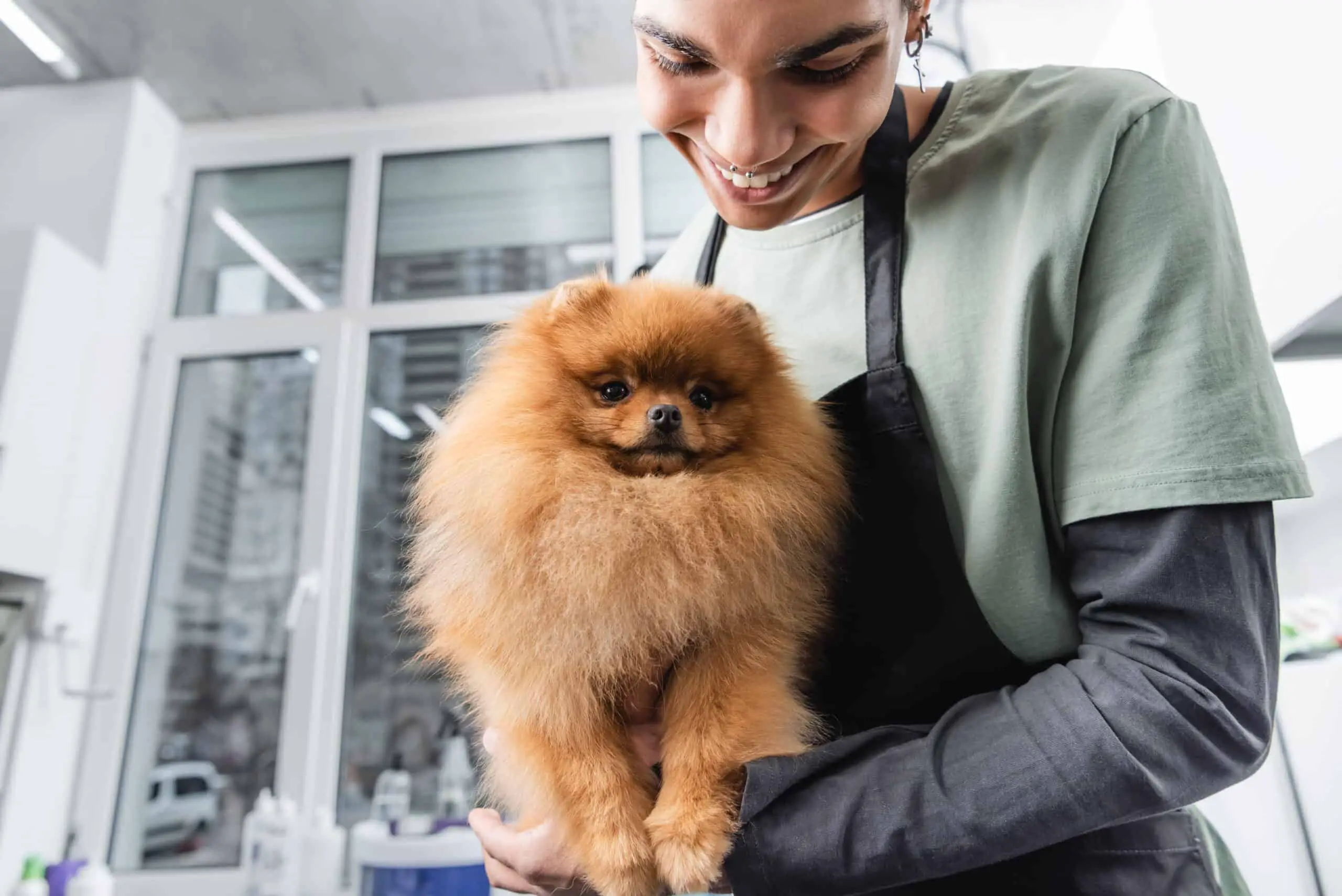
Grooming Your Teacup Pomeranian
Teacup Pomeranians are known for their adorable and fluffy appearance. However, their thick double coat requires regular grooming to keep them looking and feeling their best. In this section, we will discuss how to groom your Teacup Pomeranian to ensure that they stay healthy, happy, and beautiful.
Since Pomeranians have the soft undercoat, the fur gets compacted close to the bottom of the bristles of any brush you use. That said, it is difficult to clean a brush that doesn’t have the self-cleaning feature of retractable bristles.
Brushing: One of the most important aspects of grooming your Teacup Pomeranian is brushing their coat. They have a thick double coat that requires regular brushing to prevent matting and tangling.
You should brush your Pomeranian at least once a day, using a soft-bristled brush or a self-cleaning wire slicker brush like this Hertzko Self-Cleaning brush to remove any loose fur and dirt.
You should also use a comb to work out any tangles or mats gently. The Cafhelp Metal Dog Comb is sturdy and helps you get a good grip.
Though they are moderate shedders throughout the year, they will shed heavily, pushing out their undercoat, twice a year. Usually this is called a “seasonal shed” it may not occur the typical times of the year.
Typically seasonal shed occurs during the spring and autumn in preparation for a change in weather. However, our Pommie would shed in January and mid-July. Even though she was determined to be healthy by a vet, her body was on a different schedule.
Bathing: Teacup Pomeranians do not require frequent baths, as this can strip their coat of natural oils and lead to dry skin. However, you should bathe your Pomeranian every 4-6 weeks or as needed.
Use a gentle dog shampoo and warm water to bathe them, being careful not to get water or shampoo in their eyes, ears, or nose. Rinse them thoroughly and use a towel to dry them off.
You will want to blow dry them completely to prevent matting. Do this for any double-coated dog that you own.
Fur trimming: Teacup Pomeranians require regular trimming to keep their coat looking neat and tidy. You can trim their fur using scissors or clippers, being careful not to cut too close to the skin.
Pay particular attention to the fur around their paws, behind their ears, and tail, as this can be prone to matting and tangling.
Nail Clipping or Grinding: Teacup Pomeranians have small, delicate paws, and their nails can quickly become overgrown if not trimmed regularly. If left un-trimmed, the nails will force them to walk on further back on their feet which throws off their joints and spine. Over time this can contribute to skeletal issues.
You should trim their nails every 2-4 weeks, using a sharp nail clipper designed for dogs. Be careful not to cut the quick, which is a blood vessel that runs through the nail, as this can cause bleeding and discomfort.
If you would like more information on How To Grind Your Dog’s Nails Safely.
Teeth Care: Teacup dogs are prone to tooth decay, and you should take steps to keep their teeth clean and healthy.
You should brush their teeth regularly using a soft-bristled toothbrush and dog toothpaste. That said, when we had our Pom, we had a hard time finding a brush that was small enough. The Mind Up toothbrush might have worked if it had been around when Phoebe was alive.
Also, this Petosan Double Headed X-Small Dog Toothbrush, with bristles that will reach both the inside and outside of your dog’s teeth at the same is a great choice. It will get the job done faster.
However, if that brush is still too big, you might just use a clean microfiber cloth and rub it around your dog’s teeth every night. They are available in discount stores, like Dollar Tree, in a three pack.
Start teeth cleaning with them as soon as possible. The younger the better.
You can also give them dental chews to help remove plaque and tartar buildup. Please consider the quality of the dog chew that you use. There have been problems associated with pea and potato flour. There are a lot of products out there that contain these two ingredients.
Also, rawhide has been deemed to be problematic.
One of the best we have found is Natural Farm Odor-Free Bully Sticks made from grass-fed beef. These are 6 inches but for a small dog, you can cut them into 2″ sections so that they are easier to handle. It will also extend the life of the pack. They are pricey but they are of such good quality that they are worth it.

Adopting and Owning a Teacup Pomeranian
Special Traits: Teacup Pomeranians are known for their friendly and playful personalities. They are intelligent and eager to please their owners, which makes them easy to train.
They are also very loyal and protective of their owners, which makes them great watchdogs. These yappy dogs have been known to be excellent security systems.
Teacup Pomeranians are affectionate dogs and enjoy spending time with their owners. They also tend to have a lot of energy, which makes them great for families with children.
However since they look like toys, it is critical that dog owners watch them around young children who do not understand that they are somewhat delicate.
Cost of Purchase: The cost of purchasing a Teacup Pomeranian varies depending on the breeder and location. On average, the cost of a Pomeranian teacup puppies range from $1,000 to $4,000. However, some dog breeders may charge more depending on the dog’s size, coat color, and pedigree.
Maintenance Costs: Teacup Pomeranians require regular grooming, which can be costly. They have a thick double coat that requires regular brushing and trimming to prevent matting and tangling. You should also bathe them every 4-6 weeks, trim their nails every 2-4 weeks, and brush their teeth regularly. The cost of grooming your Teacup Pomeranian can vary, but on average, it costs around $50 per session.
Special Training: Teacup Pomeranians are intelligent dogs and are easy to train. However, they require special training to ensure that they are well-behaved and obedient. Teacup Pomeranians can be prone to barking and other behavioral issues if not properly trained. The cost of training your Teacup Pomeranian can vary, but on average, it costs around $100 to $200 per session.
Medical Costs: Teacup Pomeranians are prone to certain medical conditions, such as dental problems, luxating patella, and hip dysplasia. The cost of treating these conditions can vary depending on the severity of the condition and the location of the vet. It’s important to budget for unexpected medical expenses when owning a Teacup Pomeranian.
Finding Breeders: Finding a reputable breeder for Teacup Pomeranians can be difficult. It’s important to do your research and ensure that the breeder is reputable and has a good track record. You can also consider adopting a Teacup Pomeranian from a rescue or shelter.
Fun Fact: They were popularized by Queen Victoria, who owned several Pomeranians during her reign. At one time she had 35 Pomeranians for both pets and for show. These tiny dogs became a favorite of royal families all over the world.
FAQs on the Teacup Pomeranian
Do all Pomeranians go through uglies?
There is a common, natural phase that a Pom goes through called the “Pomeranian uglies,” also known as the “Pomeranian puppy uglies.”
The next three photos will show the progression from puppy through the uglies to around one year old.
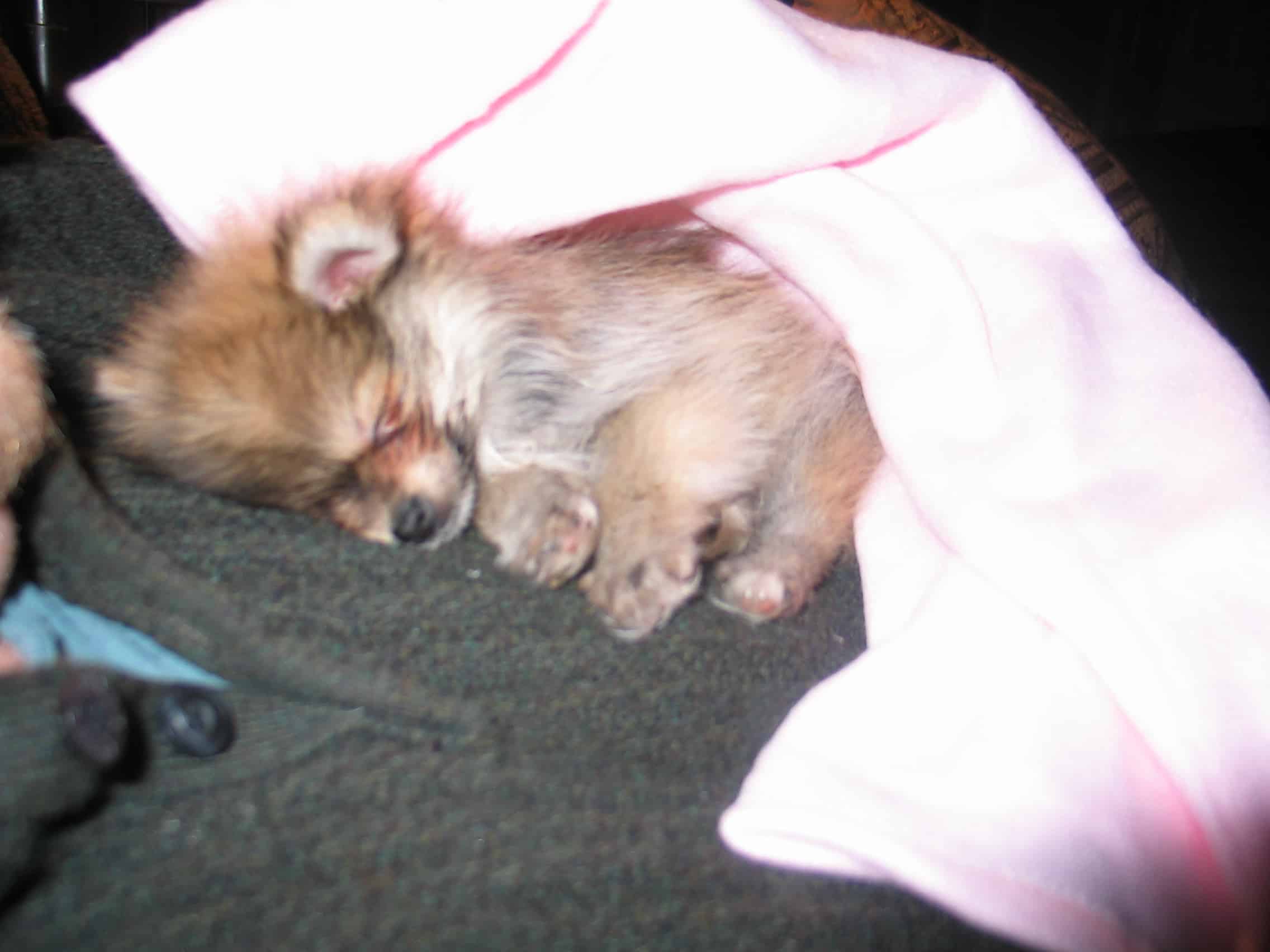

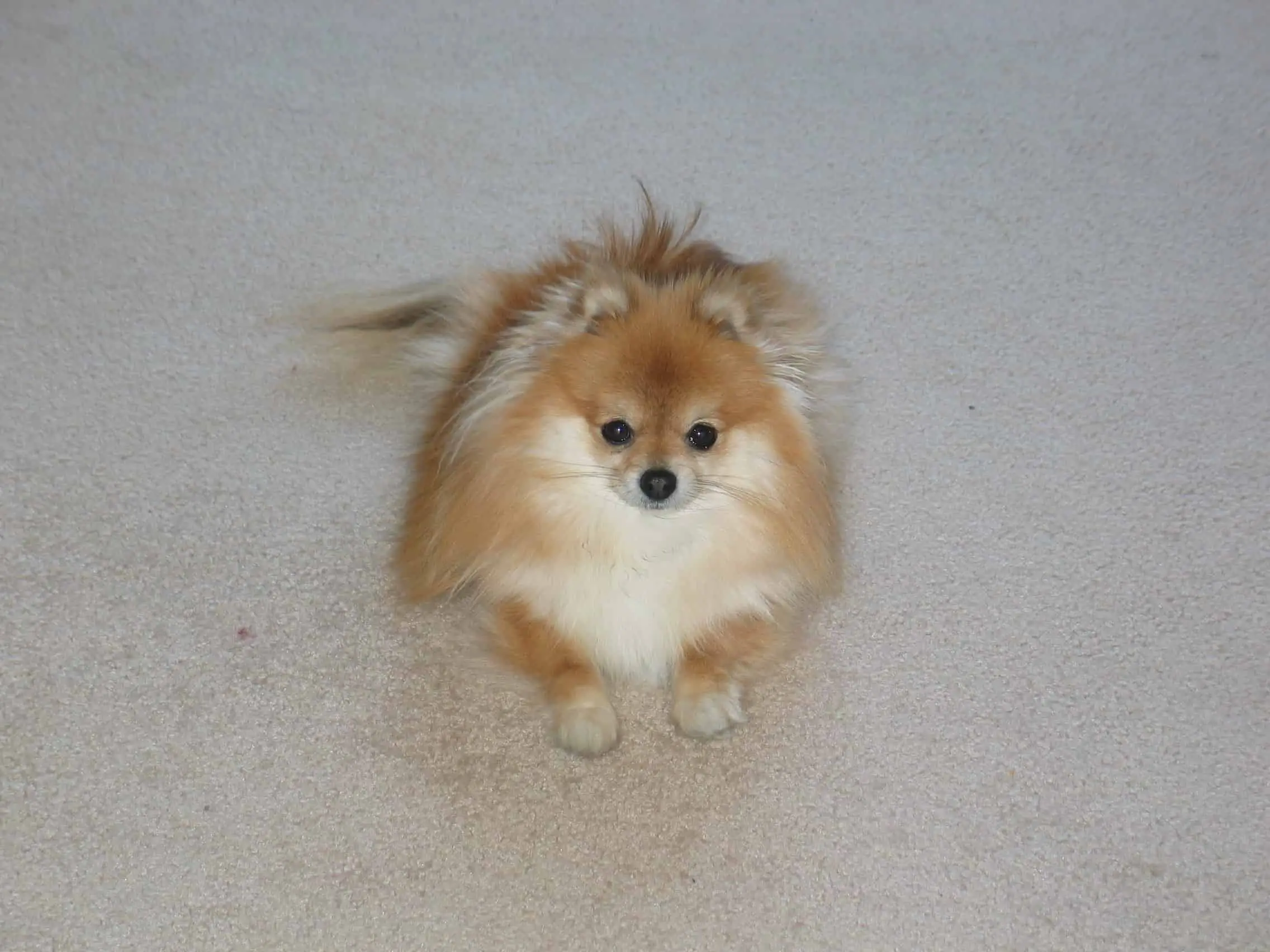
It is a term used to describe a period of time in a Pomeranian’s life when they go through an awkward phase of physical development. This phase typically occurs between the ages of 4 to 8 months and can last for six months up to a year, during which Pomeranians may experience a significant change in their coat and physical appearance.
During the Pomeranian uglies phase, puppies may experience shedding, thinning of their coat, and changes in their fur texture. Their once fluffy and cute appearance may be replaced with patchy hair, thinning hair, and a less attractive appearance overall.
This stage can be frustrating for Pomeranian owners who were expecting their puppies to maintain their cute, fluffy appearance forever.
The reason why Pomeranians go through the uglies is due to their unique coat structure. Pomeranians have a double-layered coat, with a soft, dense undercoat and a long, silky topcoat.
As puppies, their undercoat is the first to develop and may cause their fur to appear thick and fluffy. However, as their topcoat starts to grow in, their undercoat will shed and cause the puppy to look patchy and uneven.
While it may be discouraging to see your Pomeranian puppies go through the uglies phase, it is a completely normal and temporary stage of development. In fact, most Pomeranians will go through this phase at some point in their lives.
The best thing you can do during this time is to provide your puppy with a balanced diet that includes high-quality protein, healthy fats, and essential vitamins and minerals, grooming, and lots of love and patience.
Regular grooming is also essential during the uglies phase. Brushing your Pomeranian’s coat daily can help remove loose hair and prevent matting. You may also want to consider taking your puppy to a professional groomer who can help maintain their coat and keep them looking their best.
Patience and it’s important to remember that this phase is temporary and that your puppy will eventually grow out of it.
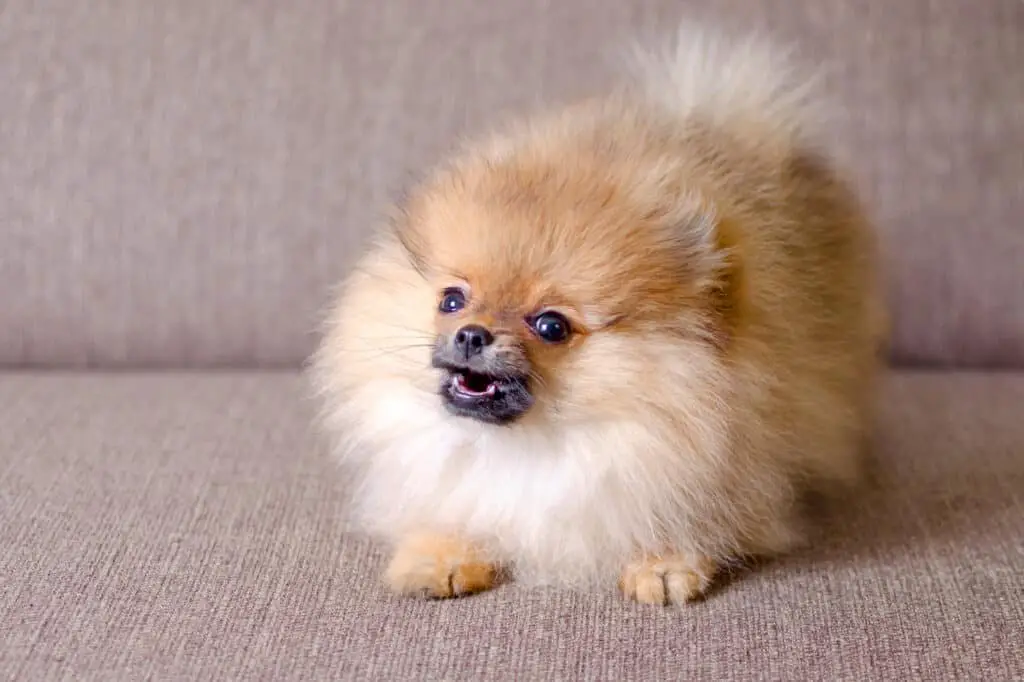
What is the downside to owning a Teacup Pomeranian?
They bark…a lot! This is especially true if you have more than one Pom (or any other excitable dog). They will take cues from the other yappers/barkers.
Phoebe was a single dog and would stop barking on command. We always allowed her to bark a little at the doorbell (or the doorbell on a TV commercial) because that was part of her job of alerting us. But we stopped her after a little while.
One big drawback to having such a small dog is that when it comes to emergency veterinarian care, it may be difficult to find a doctor that can perform surgery on such a small dog. A full-grown Teacup Pomeranian can be smaller than some newborn puppies of other breeds. The smallest dogs aren’t always healthy dogs.
Many medical instruments are too big to use on them and dosing medications is especially difficult.
Putting any dog under anesthesia is concerning, however, for small dogs it’s especially harrowing. And, even though we brushed Phoebe’s teeth as much as possible, she still needed professional cleaning and scaling periodically. Putting her under was a gamble every time.

The Bottom Line on the Teacup Pomeranian
The Teacup Pomeranian is a lovable and friendly breed of dog that makes a great pet for those looking for a loyal companion. They are intelligent and trainable, and with the right care, they can live long and happy lives.
However, they are prone to several health issues, and it’s essential to be aware of these issues and take steps to prevent them. If you are considering getting a Teacup Pomeranian, be sure to do your research and talk to your vet about any concerns you may have.
Grooming your Teacup Pomeranian is an essential part of keeping them healthy and happy. Regular brushing, bathing, trimming, nail care, and teeth care are all important aspects of grooming your dog. By following these tips, you can help ensure that your Teacup Pomeranian looks and feels their best, and enjoys a long and healthy life with you.
Owning or adopting a Teacup Pomeranian can be a rewarding experience. These small and adorable dogs are full of personality and make great companions. However, they require regular grooming, training, and medical care, which can be costly. If you’re considering owning a Teacup Pomeranian, it’s important to do your research and ensure that you can provide the necessary care and attention for them to thrive.
Please read our Legal Disclaimer

